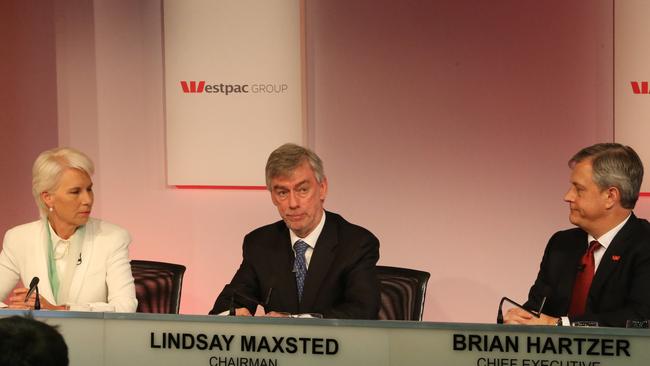Westpac’s response to Austrac scandal completely inadequate

There are still plenty of questions.
Specifically, why did Westpac set up the two non-SWIFT cross-border payment platforms - Australasian Cash Management (ACM), for large amounts, and LitePay, for small ones - that are at the core of the allegations? Who made those decisions and what were they thinking?
In the Austrac statement of claim, the references to ACM date back to November 5, 2013, which was under Gail Kelly’s watch. LitePay was established in 2016, after Brian Hartzer took over.
READ MORE: Brian Hartzer hangs on as Westpac cuts bonus | Westpac executives could be disqualified, fined |
SWIFT stands for Society for Worldwide Interbank Financial Telecommunication. It was established in 1973 to replace telex machines and has become the global standard for cross-border money flows, with elaborate systems for preventing financial crime.
It seems that both ACM and LitePay were set up specifically to provide customers with a low-cost and simpler alternative to SWIFT.
In its statement of claim, Austrac says: “Westpac considered that the SWIFT payment network was costly and not an efficient means of sending low value, large volume payments for clients of global banks that need to make and receive payments around the world.”
The trouble is that “Instructions sent through the non-SWIFT ACM arrangements do not contain the full information required by the SWIFT Guidelines”.
From November 5, 2013 to September 3, 2018, Westpac received 19.4 million transfers totalling more than $11 billion via the ACM platform. None of them was reported to Austrac within 10 business days as required.
But it was far worse than late reporting: “At no time did Westpac carry out an appropriate assessment of the inherent risks it may reasonably face that the banking services provided through each of the correspondent banking relationships might (inadvertently or otherwise) involve or facilitate money laundering or financing of terrorism, as required by s 98(1) of the Act”.
Then follow several pages describing Westpac failures to follow its own standards of due diligence for correspondent banking and risk assessment.
“Westpac had limited or no visibility over the sources of funds … there were no caps or limits on the volume and/or value of cross-border transactions through these arrangements,” Austrac alleges.
There was no reference to the reasons for establishing the ACM platform in the weekend release from Westpac, beyond the statement that “the relevant” ACM product has been closed, whatever that means.
LitePay flawed
As for LitePay, according to the statement from Westpac it was “launched with detection monitoring scenarios in August 2016 prepared with regard to industry guidance issued by Austrac at the time.”
In December 2016, Austrac issued Westpac’s financial crime team with new guidance regarding the purchase of “child exploitation material” from the Philippines and South East Asia.
But Westpac failed to update its “detection monitoring scenarios” for 18 months, and it appears 12 customers slipped through that gap.
But it seems to be worse than that. According to Austrac: “By no later than May 2016, Westpac itself had assessed the heightened child exploitation risks associated with low value payments to the Philippines through LitePay and other channels”.
In August 2016, Westpac put in place an “automated detection scenario”, but it was inadequate, and it didn’t work. “It was not until June 2018 that an appropriate automated detection scenario was implemented to monitor the LitePay channel for the known child exploitation typologies involving the Philippines.”
In other words, Westpac knew that LitePay may have been used for buying child pornography from the Philippines but did nothing about it.

These allegations are far more serious than the weekend statement from Westpac suggests. Simply acknowledging, as it does, that it should have implemented more robust transaction monitoring earlier than it did is nowhere near good enough.
That stable door has also now been closed. Visit the LitePay section of Westpac’s website now and you get: “This web page has moved or no longer exists.” The product has been abruptly closed down.
Westpac blindsided
Lindsay Maxsted’s press release said Westpac understood the gravity of the issues, expressed “deep sorrow” and accepted responsibility. But the rest of the statement was largely an attempt to either deflect blame or suggest Westpac had already been dealing with the issues for some time, including working with Austrac.
But actually, Austrac completely blindsided the bank with the LitePay allegations, which was not the act of a happy regulator working closely with Westpac, as suggested.
In fact, what emerges from the statement of claim is that for years Westpac management either turned a blind eye to, or knowingly allowed, ACM and LitePay to be used for money laundering, tax evasion and child exploitation.
Lindsay Maxsted and/or Brian Hartzer need to explain why those products were set up in the first place and why we shouldn’t conclude they were actually designed to help crooks and paedophiles.
And the accountability should include Gail Kelly, who received $11 million in her last full year (2014), including a cash bonus of $2.7 million and shares worth more than $5 million.
Alan Kohler is Editor in Chief of InvestSMART.com.au



Yesterday’s statement from Westpac chairman Lindsay Maxsted goes nowhere near answering the questions arising from the Austrac allegations. It’s a start, but that’s all.